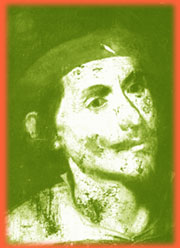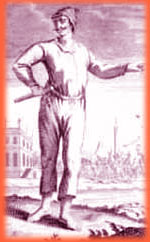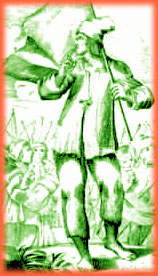|
 The
true name of Masaniello is Tommaso Aniello d'Amalfi;
he was born in Naples in 1620.
The
true name of Masaniello is Tommaso Aniello d'Amalfi;
he was born in Naples in 1620.
His origins are very humble: his family was poor,
he was illiterate and he earned his daily bread
working as boy of a fishmonger in the Mercato
quarter. It has been told he was really sharp
and smart and that he had sometimes violent reactions.
Because of this behaviour, he was often put in
the Ammiragliato prisons.
In prison he met doctor Marco Vitale, a G. Genoino
follower who let Masaniello contact with the middle-class
supporters of the coming riot. Masaniello met
there also Genoino, one of the main protagonists
of the uprisings against the nobles occured in
1620. Genoino was a supporter of a reform for
the city government; he suggested a delegation
of lower classes could vote as the nobles did.
Vitale and Genoino acknowledged Masaniello as
the one who had the character and the ambition
to foster and sway the crowd in order to revolt.
The excuse of the riot occured in 1647 was the
restoration of the fruit tax.
In june 1647 some incidents between people and
the leading classes happened.
On 7th july 1647 Masaniello led a popular protest
demonstration against the fruit tax; this demonstration
led to a riot that involved also the quarters
near the Mercato one. Masaniello suggested the
shopkeepers to refuse paying the fruit tax. The
revolt forced the viceroy Duke of Arcos to escape.
Masaniello and common people controlled therefore
the city. Also the "civil" people led
by Genoino took part to this first riot phase;
Genoino and some other agitators gave indeed orders
from the Carmine church. After the viceroy escape,
some reforms in the administrative, military and
economic fields (new price-lists were passed)
were made. Cardinal Filomarino, archbishop of
Naples, was the mediator with the Spanish government;
the two parts came to a series of agreements,
according to which invaders did not lose their
power and the common people demands were accepted.
On 13th july taxes were officially abolished.
It was not the glory time for Masaniello because
he had to defend himself from hie enemies.
On 10th july the duke of Maddaloni organized an
attempt on Masaniello's life, who was able to
foil it. Thanks to this event, the viceroy tried
first to corrupt him and then he was forced to
designate him "very faithful general capitain
of Naples people". Masaniello had great prestige
among common people and he  was
able to keep them united against the Spanish.
This support let him have many enemies among the
craftmen and the dealers, who were afraid for
their activities. The sudden fame and success,
being abandoned by his supporters made him upset.
In a couple of dayd he got crazy. On 16th july
Masaniello was murdered according to someone by
his fellows; others think he was killed by viceroy
hired assassins who found him in the Carmine church,
where he was hidden. His funerals were the first
step of the Antispanish riot that from Naples
spread in the reign provinces. was
able to keep them united against the Spanish.
This support let him have many enemies among the
craftmen and the dealers, who were afraid for
their activities. The sudden fame and success,
being abandoned by his supporters made him upset.
In a couple of dayd he got crazy. On 16th july
Masaniello was murdered according to someone by
his fellows; others think he was killed by viceroy
hired assassins who found him in the Carmine church,
where he was hidden. His funerals were the first
step of the Antispanish riot that from Naples
spread in the reign provinces.
Masaniello has often been reproached for having
not an historical awareness, but this idea did
not prevent from creating his myth as a popular
hero. Much was written on Masaniello, who inspired
many theatre works.
|




 The
true name of Masaniello is Tommaso Aniello d'Amalfi;
he was born in Naples in 1620.
The
true name of Masaniello is Tommaso Aniello d'Amalfi;
he was born in Naples in 1620. 
 was
able to keep them united against the Spanish.
This support let him have many enemies among the
craftmen and the dealers, who were afraid for
their activities. The sudden fame and success,
being abandoned by his supporters made him upset.
In a couple of dayd he got crazy. On 16th july
Masaniello was murdered according to someone by
his fellows; others think he was killed by viceroy
hired assassins who found him in the Carmine church,
where he was hidden. His funerals were the first
step of the Antispanish riot that from Naples
spread in the reign provinces.
was
able to keep them united against the Spanish.
This support let him have many enemies among the
craftmen and the dealers, who were afraid for
their activities. The sudden fame and success,
being abandoned by his supporters made him upset.
In a couple of dayd he got crazy. On 16th july
Masaniello was murdered according to someone by
his fellows; others think he was killed by viceroy
hired assassins who found him in the Carmine church,
where he was hidden. His funerals were the first
step of the Antispanish riot that from Naples
spread in the reign provinces.